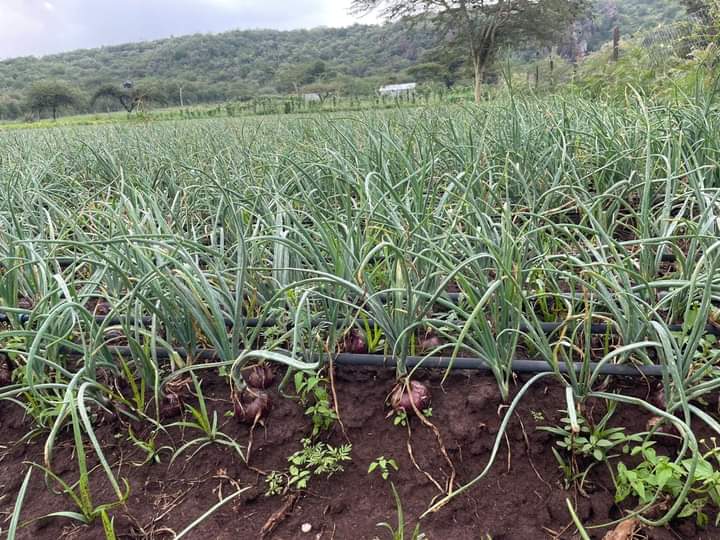
According to a 2014 report from the Food and Agriculture Organization (FAO), approximately half of Kenya’s red onion supply is imported from Tanzania. Despite efforts by Kenyan farmers to meet demand, there remains a significant gap in local production. This presents a lucrative opportunity for commercial investment in the cultivation of red bulb onions in the Kenyan market.
In Kenya, two main types of onions are cultivated: bulb onions and spring onions. The most suitable regions for onion farming include Karatina, Oloitoktok, Naivasha, Kieni, Emali, and Mai Mahiu.
Bulb onions typically take between three to four months to mature. The short rains, occurring between January and February, are optimal for harvesting bulb onions, coinciding with low onion supply from Tanzania. Farmers can capitalize on this period, as prices tend to rise after the long rains in March, resulting in favorable profit margins.
Spring onions are relatively easy to grow and can even be cultivated in kitchen gardens. They are commonly used in salads and as seasoning in soups. Spring onions offer various health benefits, such as lowering blood sugar and reducing blood pressure and cholesterol levels.
Of the two types, bulb onions are preferred due to their extended shelf life and sweeter taste. Currently, two distinct varieties of bulb onions are available in the market: the small, firmly layered onions with a strong pungent aroma imported from Tanzania, and the larger, locally grown variety with looser layers.
Essential Conditions for Profitable Onion Farming
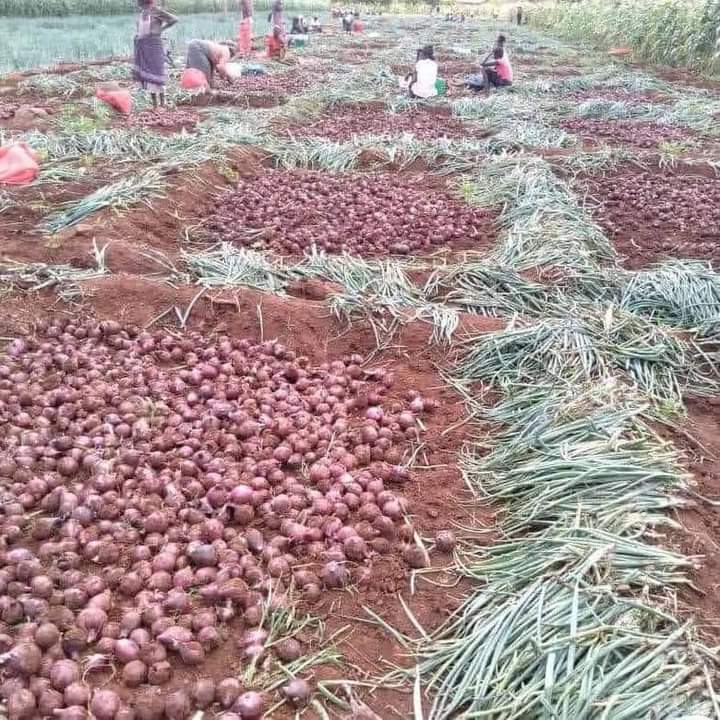
- Soil Requirements: Onions thrive in well-drained, fertile, sandy loam soils that are not compacted. The ideal soil pH ranges from 5.8 to 6.8. It’s recommended to conduct soil tests with accredited laboratories to ensure the soil meets these criteria.
- Year-round Cultivation: With the aid of irrigation, onions can be grown throughout the year. This flexibility makes onion farming a lucrative venture.
- Temperature Range: Onions require temperatures between 13°C to 35°C for optimal growth. This wide temperature tolerance allows for cultivation in most parts of Kenya. However, to enhance production in hotter regions like Ukambani and certain coastal areas, greenhouse infrastructure and drip irrigation are advisable. Greenhouses regulate temperatures effectively, while drip irrigation ensures consistent water supply, crucial in arid environments. Notably, onions are considered cool-season crops, a factor to consider in regions with extremely dry climates.
- Essential Resources: Besides land, necessary resources for onion farming include DAP fertilizer and seedlings. Typically, 1 kg of seedlings covers 1 acre of land, while 20 grams of DAP fertilizer are applied per square meter.
- Varietal Considerations: Different onion seed varieties perform distinctively under varying conditions. Popular hybrid varieties in Kenya, such as Red Coach F1 and Malbec F1, offer unique advantages. Among these, Red Coach F1 stands out for its high yield potential and ideal onion size and color, making it highly sought-after in local markets. Selecting the right seed variety is crucial for maximizing production and market appeal.
Land Preparation
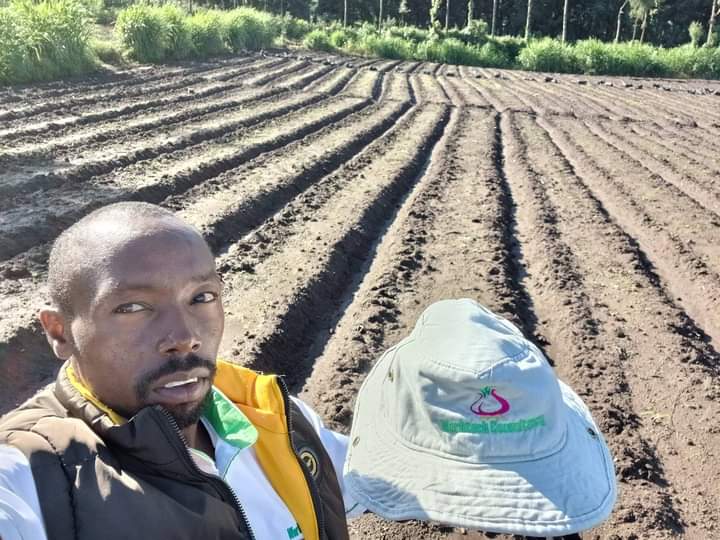
- Plough the Land: Begin by plowing the land approximately one month before transplanting the onion seedlings. This process helps to loosen the soil and prepare it for further cultivation.
- Soil Raking: After plowing, rake the soil thoroughly for two weeks to break down clumps and create fine particles. This step promotes better seedling establishment and root penetration.
- Incorporate Organic Manure: Incorporate 20-25 tonnes per hectare of ripe animal manure, such as poultry or cow dung, into the field. This organic fertilizer enriches the soil, enhances its structure, and improves moisture retention over an extended period. Ensure thorough mixing of the organic manure with the soil.
- Prepare Transplanting Holes: Prior to transplanting the onion seedlings, prepare the furrows or planting rows as desired. When planting, add the organic manure directly to each planting hole instead of mixing it uniformly with the soil. This localized application ensures that the seedlings receive adequate nutrients and promotes healthy root development.
Transplanting

- Timing and Seedling Height: After six weeks of germination, when the seedlings reach a height of 12 to 15 cm, they are ready for transplanting.
- Pre-Transplantation Watering: To prevent root damage during transplanting, thoroughly water the seedbed the day before transplanting.
- Uprooting and Pruning: Use a shovel to gently uproot the seedlings from the seedbed. Remember to prune both the leaves and roots to enhance water retention and reduce transplant shock.
- Planting Spacing: Plant the seedlings in rows with a 30 cm space between rows and 8 to 12 cm between each seedling. This spacing optimizes growth, ensuring early maturity and maximizing yield per area.
- Seedling Selection: Choose healthy, pest-free seedlings for transplanting, avoiding very young or old ones.
- Planting Depth and Timing: Transplant the seedlings at the same depth as they were in the nursery. Opt for transplanting in the morning or evening to minimize heat stress on the seedlings.
- Watering After Transplantation: Immediately after transplanting, water the seedlings thoroughly. Continue to water in the morning and evening until the seedlings establish well in the soil.
Pest and disease control
Onions are susceptible to several common conditions, including blight, purple blotch, and thrips, which are primarily caused by fungal infections and thrive in high moisture environments.
- Blight: Characterized by small white spots encircled by a greenish halo, blight can significantly damage onion crops. It tends to occur during periods of elevated moisture levels.
- Purple Blotch: This condition leads to purplish discoloration of onion leaves, affecting their health and vigor. Like blight, purple blotch is exacerbated by moist conditions.
- Thrips: Thrips are tiny, sucking insects that can attack onion plants, causing leaves to turn grey or silvery. These pests are barely visible, typically appearing as tiny yellow or dark specks about 1 mm long. Organic controls such as safer soap or Pyrethrin can be effective against thrips.
To mitigate these issues, proper plant spacing is crucial to increase airflow and reduce the likelihood of fungal infections like blight and purple blotch. Additionally, vigilant weed control is essential, as thrips can hide in weeds. After harvest, thoroughly weed the garden patch and maintain weed control in the onion bed throughout the growing season to minimize thrips infestations and ensure healthy onion crops.
Onion Farming in Kenya: Fertilizer Application
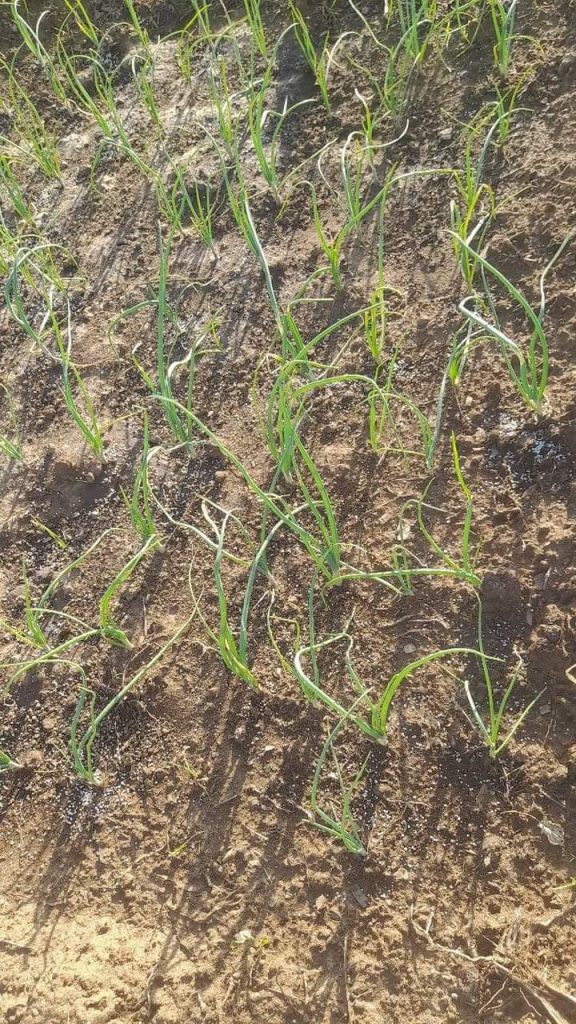
The optimal fertilizer for onions is one that fulfills their specific nutritional needs while maintaining a balanced nutrient profile. For instance, onions require ample nitrogen for robust growth and bulb development. However, excessive nitrogen can stimulate excessive foliage growth, potentially compromising bulb formation.
In cases where soil tests reveal high nitrogen levels, it’s advisable to supplement with potassium. Potassium plays a vital role in enhancing onion shelf life. Additionally, sulfur fertilizer may be necessary if soil sulfur levels are low, as sulfur aids in nitrogen uptake, thereby improving yields.
Magnesium is another essential nutrient for onions, facilitating chlorophyll production and nutrient absorption. Moreover, magnesium contributes to prolonged onion storage capabilities, ensuring freshness over extended periods.
Boron fertilizer is often overlooked but holds significant importance in onion cultivation. It enhances storage quality, regulates carbohydrate metabolism, and promotes calcium movement within the plant.
Calcium supplementation is crucial for onion growth and resilience. It promotes plant height, shields bulbs from abiotic stresses like salinity, and boosts disease resistance. Calcium application is particularly beneficial in disease-prone soils, strengthening crop immunity.
Organic fertilizers are highly recommended for onion cultivation due to their environmental sustainability and soil-enhancing properties. Organic fertilizers improve soil structure, promote microbial activity, and have been shown to significantly increase yields and quality. Embracing organic fertilizers can lead to yield boosts of up to 30% and quality improvements of up to 50%, providing long-term benefits for onion farmers and the environment alike.
Onion Varieties in Kenya

The success of an onion farming enterprise hinges greatly on the choice of seed variety, tailored to local climatic conditions and market demands. Various factors, including suitability for export and market size preferences, must be considered. Here are some noteworthy onion varieties:
- Red Creole Onion:
- Well-suited for hot climate regions with low rainfall requirements.
- Exhibits long shelf life, favored by traders, and esteemed by consumers for its pungent flavor.
- Resistant to pink rot disease, making it resilient in affected soils.
- Yields small to medium bulbs, with a potential harvest of 15 – 28 tonnes per acre, making it suitable for commercial cultivation.
- Red Couch F1:
- A hybrid variety resistant to pink rot, boasting a maturity period of 80 – 90 days.
- Features medium to dark red bulbs with a flattened globe shape, preferred by the hotel and catering industry.
- Requires a minimum investment of 100,000 – 150,000 per acre, offering a yield potential of 20 – 30 tonnes.
- Exhibits excellent storage capabilities, lasting up to 90 days without spoiling.
- Texas Early Grano:
- Characterized by its white gold color and mild pungency, appealing to hotel preferences.
- Matures in 120 days and adaptable to various ecological zones except those with pink rot-infected soils.
- Red Pinoy:
- Versatile variety suitable for multiple ecological zones and ideal for export markets due to its six-month shelf life.
- Boasts a high yield potential of 25 – 30 tonnes and exhibits resistance to diseases like purple blotch and downy mildew.
- Red Passion F1 Onion:
- A hybrid red onion suitable for low and medium-altitude regions, resistant to diseases such as purple blotch and pink rot.
- Features excellent curing and storage capabilities and matures in 90 days.
- Notable for its ability to maintain yields despite purple blotch-infected soils, showcasing resilience and reliability.
Selecting the appropriate onion variety aligns with farming goals, local conditions, and market demands, ensuring optimal yield and profitability.
Harvesting
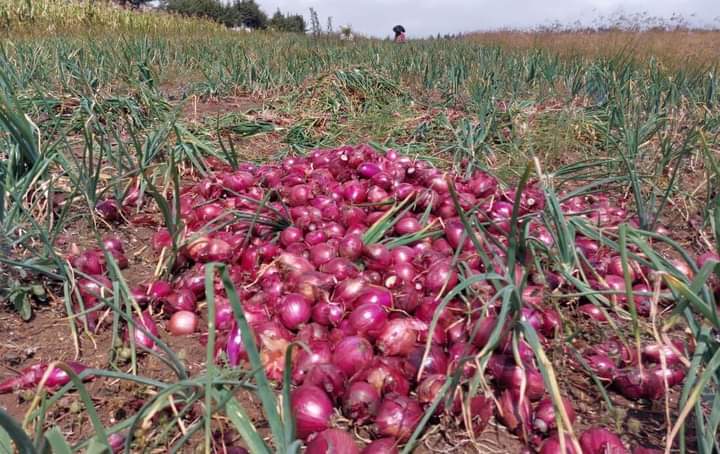
Onion harvesting typically occurs within three to five months (90-150 days) after sowing seeds, although this timeline may vary based on onion variety and local climate conditions.
Achieving a successful harvest hinges on diligent field maintenance, favorable weather conditions, and the selection of appropriate onion varieties. Well-managed crops have the potential to yield between 30 to 40 tons per hectare.
Harvesting should commence when approximately 50 percent of the crop exhibits signs of weakening and drying. Premature harvesting can lead to early spoilage of onions.
During harvesting, it’s essential to prune the entire stem and remove excess leaves and roots.
Following harvest, onions should be dried in a moisture-free, well-ventilated environment. Properly dried onions should then be stored in a similarly moisture-free and well-ventilated location, as wet onions are prone to rotting.
Under favorable weather conditions with low moisture levels, onions can be stored for three to six months. Smaller onions typically have a longer storage lifespan compared to larger varieties.
Implementing crop rotation after onion harvest is crucial for soil preservation and pest and disease management in subsequent planting seasons. Crop rotation helps maintain soil health and fertility while minimizing the risk of pest and disease outbreaks.